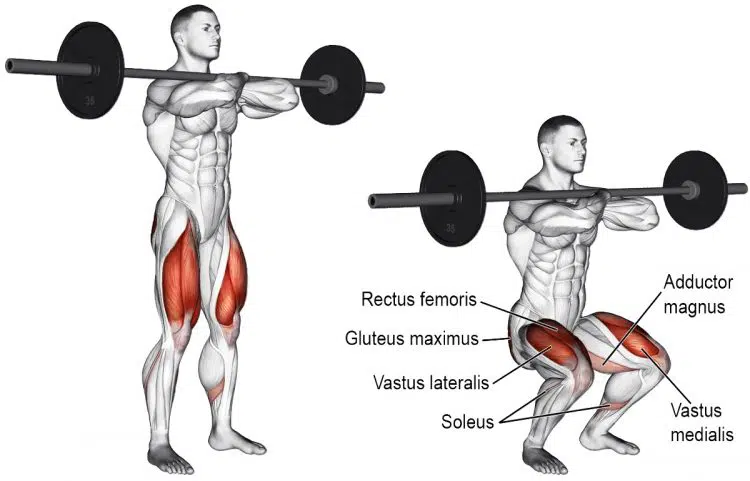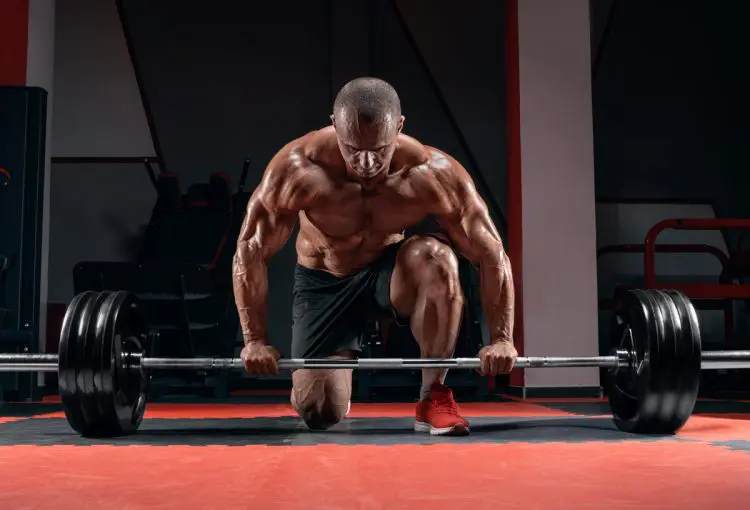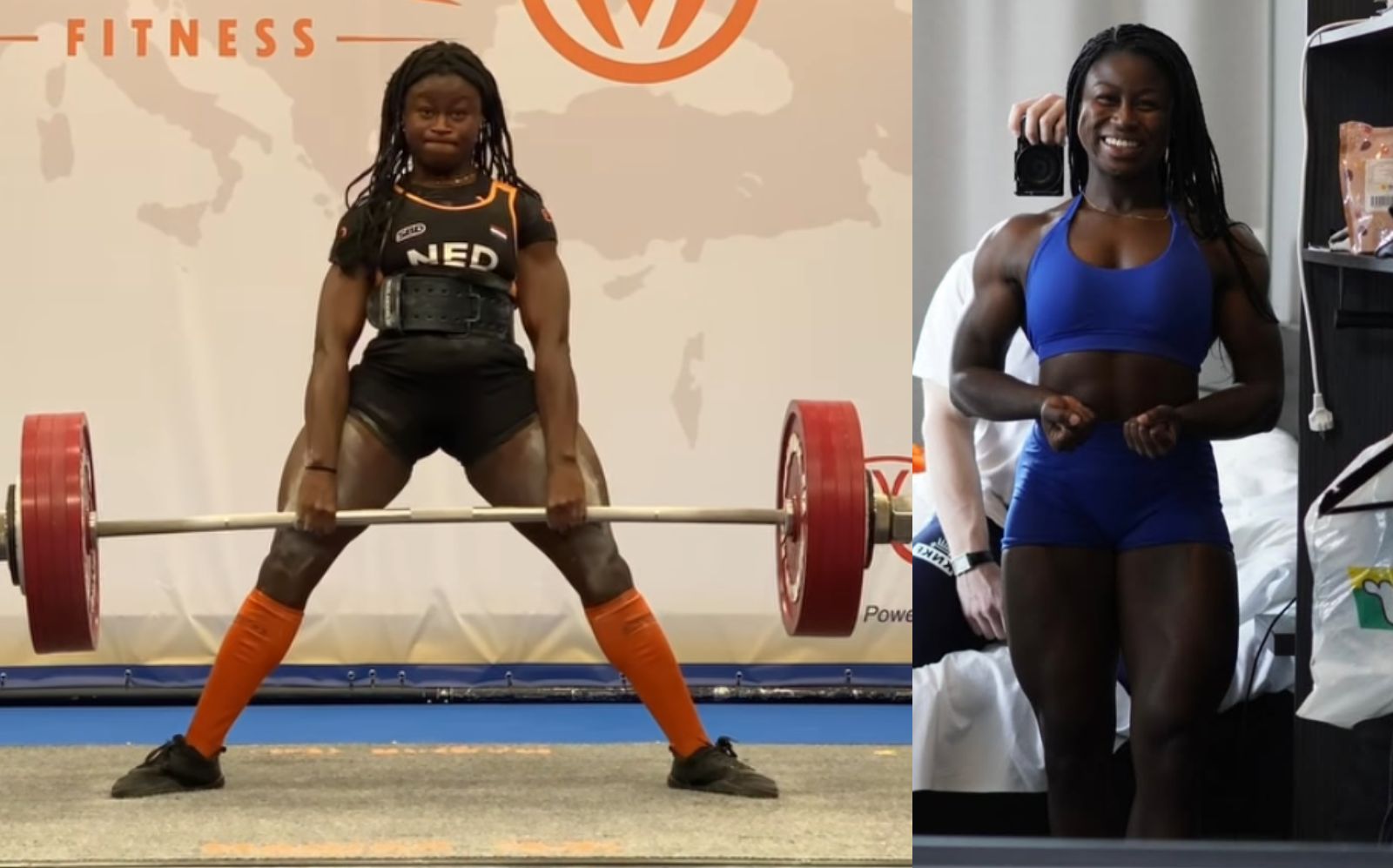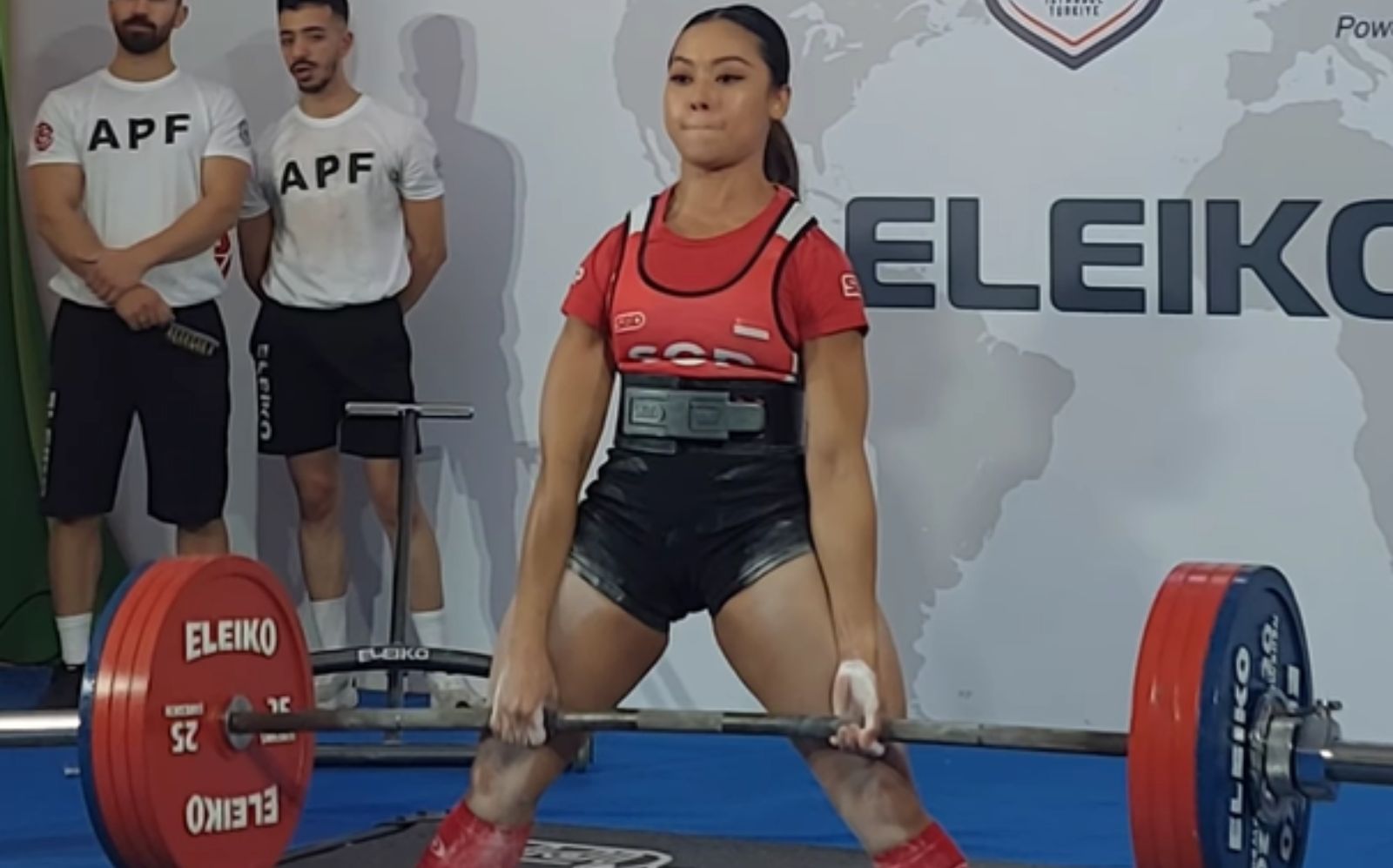The barbell front squat is simply one of the best compound leg exercises that you could ever do to build an amazing lower body, get beastly strong, and take your athletic abilities to the next level. However, it’s not ideal for everyone.
But these front squat alternatives offer similar benefits and regardless of your training experience, comfort level, or preferences, we can assure you that there’s something for everyone.
Check out our list of best front squat alternatives and try them out for yourself!
The Best Front Squat Alternatives
Here are the 9 best front squat alternatives:
1. Dumbbell Front Squat
OK, so this may be more of a variation, however, it’s also an alternative that many prefer over the barbell front squat.
The main advantage of using dumbbells over a barbell is that the former allows for more movement of the wrists and arms and it’s just more comfortable overall.
Level Up Your Fitness: Join our 💪 strong community in Fitness Volt Newsletter. Get daily inspiration, expert-backed workouts, nutrition tips, the latest in strength sports, and the support you need to reach your goals. Subscribe for free!
You can also drop the dumbbells if you must, whereas, there’s more potential for accidents using a heavy barbell.
But there is a drawback to using dumbbells and that is, you have to pick them up and clean them to your front delts first. Well, depending on how heavy the dumbbells are, this may not be possible.
But with the barbell, you can set it up to be at the desired height to where you can easily unrack it while standing.
The dumbbell front squat is an awesome exercise though, and many times, especially for those who train at home, it’s the only option.
Similarly, you could use kettlebells, or anything to add some resistance.
2. Assisted Bodyweight Squat
Why would we recommend an assisted bodyweight squat variation? Well, by holding onto something, you can ensure you maintain a more upright torso which is what a barbell front squat forces you to do, even more so than a back squat.
Basic bodyweight squats are great but sometimes, it’s harder to maintain that upright posture and many find themselves leaning too far forward.
So, you could hold onto a counter, grab a door frame, or find a method that works best for you. Additionally, you could wear a weighted vest or backpack to add more resistance.
3. Smith Machine Front Squat
The Smith machine can be a very useful tool for practicing the front squat and it’s arguably safer. The bar cannot roll anywhere and you don’t need to balance and stabilize as much to do it effectively.
One drawback may be the fixed bar path due to the machine design which may not help to develop the functional aspect unlike the free weight variation.
You may also have to adjust a bit since you cannot move as freely using most Smith machines.
While we wouldn’t say the Smith machine front squat is as good as the free weight version, it’s still a good option.
Related post: The 18 Best Smith Machine Exercises
4. Goblet Squat
The goblet squat is one of the most commonly performed front squat alternatives. And it really is a phenomenal one too.
This front squat variation is a good exercise for people of all experience levels to learn and practice maintaining proper lifting posture. Not to mention, most people will usually leave their ego at the door when choosing a kettlebell weight as opposed to a loaded barbell.
The goblet squat is usually performed by holding a kettlebell in both hands against your upper torso. You then descend into a squat and stand back up.
It’s especially hard to maintain an upright torso due to the bulk of the kettlebell but this adds to the challenge and helps to reinforce that good lifting form.
5. Resistance Band Squat
You can replicate front squat form using resistance bands. The best way to achieve this, in our opinion, is to do a split stance or Bulgarian squat.
To do it, you’ll grab both handles and stand on the center of the band with one foot while the back foot is behind you. Make sure the handles are even. Then, you’ll bring the handles near your front delts similar to a front barbell squat. Make sure that your palms are facing each other and the bands on your palm side and not over your knuckles.
Bend your front knee and squat down to the desired depth, then stand back up and lock out your knee. Do the desired number of reps and then switch legs and repeat.
You could also use looped lifting bands. Stand on the band and wrap the other end over your traps/shoulder area and use the same front squat form to do it.
6. Landmine Squat
The landmine squat is one of our faves because it’s more comfortable for your shoulders compared to the barbell front squat, more user-friendly, and arguably more fun of a movement.
To do it you may need a dedicated landmine setup that you can insert one end of your barbell into, or you can place one end in a corner that ideally has a hole to keep it secure.
You want to make sure to use an interlocking grip to perform this exercise. Using a staggered grip is not ideal because it throws your body alignment off.
You also don’t want to stand too far from or too close to the bar.
Here’s a great and short video demonstration.
Related: The 12 Best Landmine Exercises for Building Muscle Mass and Strength
7. Zercher Squat
If you’ve never heard of the Zercher squat then we’d like to introduce you to one of the most unconventional, and sometimes painful, exercises on the planet.
However, it can be a powerful weapon in your training arsenal, especially if you want to improve your functional strength.
The Zercher squat is performed by holding the barbell in the crook of your elbows rather than across your front delts.
This alone adds a component that most people are not used to. As a result, there’s a different type of recruitment and mental aspect that can help to make us more well-rounded and functional.
One big benefit of the Zercher squat is that it has better carryover to a lot of everyday tasks such as lifting and carrying heavy items. You’re having to hold the weight close to the mid part of your body like you would when picking up most objects on a daily basis.
It also helps to strengthen your lifting posture even when your shoulders are slightly rounded forward, which is actually many times necessary to lift heavy objects.
If you train for Strongman, you may also see amazing benefits of doing this exercise.
It’s also good for people with not-so-great upper-body mobility as the arms are down lower and in front of you.
Many also find that it helps to work the glutes more and is an excellent back developer.
Level Up Your Fitness: Join our 💪 strong community in Fitness Volt Newsletter. Get daily inspiration, expert-backed workouts, nutrition tips, the latest in strength sports, and the support you need to reach your goals. Subscribe for free!
Now, we mentioned that the Zercher squat can be a painful exercise. Well, it can, especially if you’re placing the bare bar in the crease of your elbows.
But you can easily fix this by using something cushioned. Then you can really load up the bar and go to town.
8. Hack Squat
Whether you use a machine or barbell to do this exercise, the hack squat forces your torso upright. The hack squat machine is a great piece of equipment because all you have to do is hop on the machine and start doing squats.
You don’t have to balance as you’re locked in and the back support is beneficial for many exercisers who have troubles with free weight squats.
Using a loaded barbell is going to be more challenging especially because you’re lifting a barbell behind your back. But it will have functional carryover and you kind of have to stay upright or you’ll probably not have success and hurt something in the process.
Also read: The Best Hack Squat Alternative for Bigger, Stronger Legs
9. Any Deadlift
The deadlift is probably the ultimate test of sheer strength. You’re pulling a loaded barbell from the ground and it allows you to lift as much weight as you can because you’re utilizing every muscle in your body to get it up.
With that being said, if you don’t have solid technique and a strong solid back, it might not end too well for you. While the upper back can be slightly rounded to pull the most weight, you still must have good scapular and upper posterior muscle strength to progress and prevent serious injury.
There are many variations of the deadlift from the basic conventional barbell version to the trap bar deadlift, Romanian deadlift and the list can go on.
Related: Front Squat Hypertrophy Guide – Build Bigger Legs.
Muscles Worked Doing A Front Squat
The above exercises will work all of the same muscles as the barbell front squat, although, to a different extent, depending on the exercise.
There are a lot of different variables that determine the degree to which two exercises compare regarding muscle recruitment and overall benefits.
For example, the Smith machine front squat won’t be as functional an exercise as the barbell variation. Then you have the dumbbell front squat that involves having to balance and stabilize two separate weights. This can be advantageous for developing symmetrical left to right strength, function, and muscle development.
Each of these best front squat alternatives has its advantages though.

Quadriceps
The quadriceps take residence on the front portion of the thigh above the knee and below the hips. While the name quads implies it’s a four-headed muscles, there are actually five – rectus femoris, vastus lateralis, vastus medialis, vastus intermedius, and tensor of the vastus intermedius.
From a standing position, squat down and then stand back up. The quads are doing their job to flex the hips and extend the knees.
Hamstrings
Not quite as impressive by numbers compared to the quads, the hamstring muscles has just three muscles/heads that are the the semitendinosus, semimembranosus, and biceps femoris. They do the opposite action of the quadriceps muscles – hip extension and knee flexion.
Hip extension occurs from the stand up phase of the squat.
Glutes
While there are three glutes – Maximus, medius and minimus, the maximus typically gets the first mention because it’s the largest muscle that we have and it forms the biggest portion of our butt and hips appearance. With that being said, our rear ends help us to extend (Straightening up after a squat) and externally rotate the thigh.
Calves
The calves receive indirect stimulation from squats and all total body activities. Calves plantarflex (point the toes town) but also help drive the feet down into the floor.
Core
Squats involve a strong core and they’ll create a strong core. Your external and deeper abdominals, back extensor muscle and obliques must be engaged to perform a squat and maintain a safe and strong position with the bar in the front rack position.
Back Muscles
Back muscles aren’t what most people think about when they perform a squat. However, how do you think it’s possible to maintain a strong upright posture? Every back muscle from the lats to the rhomboids, traps and back spinal erectors are heavily involved to support and lift heavy loads.
Posterior Delts
Possibly playing a bigger role than we think during squats, the rear deltoids do take a decent amount of the bar weight on the backside of the body.
Front Squat Benefits
The front squat has a lot of great benefits and you can expect the same from these alternatives too. Although, again, how beneficial they are compared to the barbell front squat will vary. And some may be better than the front squat in some ways.
More Muscular Legs
If you ask any gym dude what the best leg exercise is for building massive wheels they’ll probably point you to the squat rack.
The barbell back squat is arguably the most commonly performed squat. But while it’s a great exercise no doubt and everyone should use it in some form, the front squat is better in a few ways.
But as for its potential to effectively build muscle mass, a study compared the front squat and back squat and found the former to have the same effect on muscle recruitment (1).
Additionally, researchers concluded that the front squat seems to be better for those with knee issues and may be superior for long-term joint health. That’s because during the study, the back squat “resulted in significantly higher compressive forces and knee extensor moments than the front.”
Total Body Strength
Similar to how the deadlift engages the entire body, so does the front squat. Having to balance and support the bar across the front delts undoubtedly recruits the upper body muscles in a different way to the back squat.
You’ll see impressive overall strength increases if you incorporate the front squat into your workouts.
Stronger Posture
The front squat forces you into good posture, otherwise, well, you’ll drop the bar, hurt your back and not have such a productive workout.
It’s important to maintain thoracic extension to prevent injury and form a solid structure to lift from.
The front squat has excellent carryover to other lifts such as deadlift variations and other movements too.
Related: 10 Best Face Pull Alternatives: Exercises for Better Posture and Shoulder Health.
Improved Athletic Performance
The squats is an incredibly functional exercise you can do for strength, power, and explosiveness (2).
The quads, hamstrings, glutes, calves, and core muscles are all heavily worked with front squats and they’re the most important athletic muscles.
More Squat Alternative Exercises:
- Hack Squat Alternative for Bigger, Stronger Legs
- Smith Machine Squat Alternatives for Powerful, Muscular Legs
- Bulgarian Split Squat Alternatives for Stronger, More Athletic Legs
- Home Squat Alternatives for Strong, Sculpted Legs
Wrapping Up
When we put together this list of best front squat alternatives, these exercises seemed to fit the mold extremely well. Are they the only movements that can sub for the front squat?
Probably not.
But there’s something for everyone and we know most people won’t need much else to get similar benefits to the barbell front squat.
Interested in measuring your progress? Check out our strength standards for Face Pull, Zercher Squat, Smith Machine Squat, and more.










